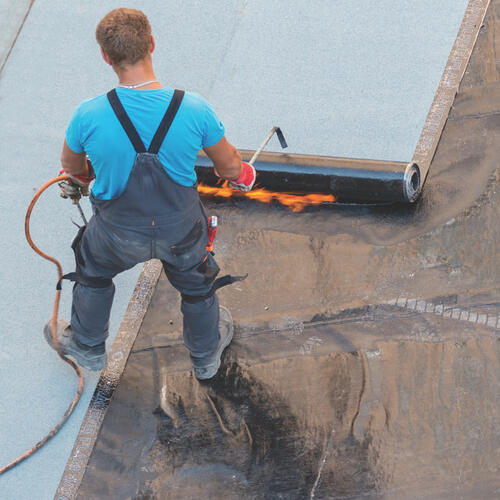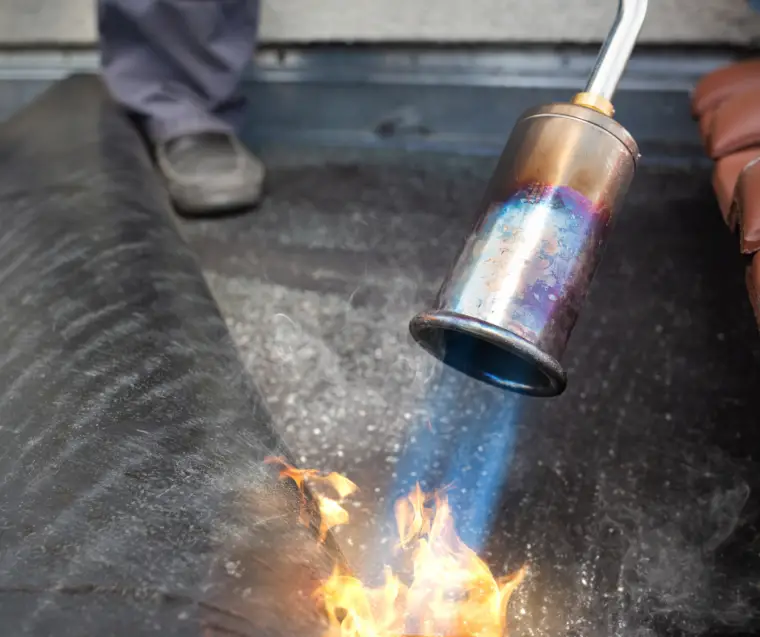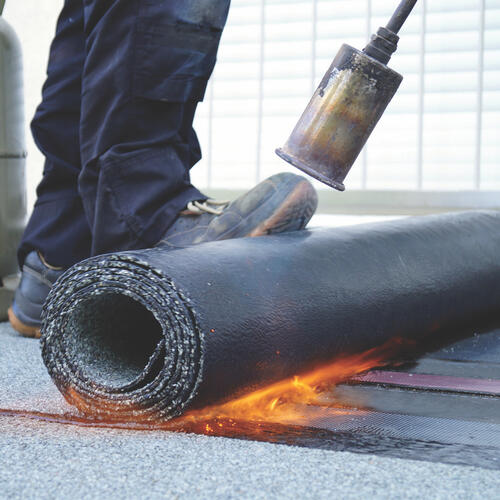Finding The Right Roofing Contractors For The Job
Finding the right roofing contractors for the job requires considerable time and patience. You cant limit yourself to just one roofing professional.
We recommend collecting as much feedback and research on various roofing contractors in an area and then narrow your choices to the contractor that can fulfill your needs the most.
You can do this by reading google reviews, calling local roofing supply companies and talking to your citys zoning department to identify who has the best reputation.
One tip we can give when choosing the right roofing contractor is to ensure theyre certified torch applicators.
Why Use Torch Down Roofing
Durability
The torch down roofing material is water-resistant, resistant to punctures, ultraviolet rays, and other damages. It requires minimal repairs and can last up to 20 years.
Flexible
The rubbery additives in the roofing material allow it to expand and contract in extreme heat and cold. This makes it ideal for low-slope or flat roofs.
Energy efficient
The roof protects against heat and UV rays. This helps lower your cooling bill during hot weather.
Water-resistant
The heat-sealed seams and ultra-water proof membrane make the torch down roofing one of the most highly water-resistant roof systems. The roof prevents water from collecting and pooling on the roof and facilitates drainage. It also protects structures from damage caused by snow buildup.
Fire resistant
The granulated cap layer is highly fire-resistant.
Easy repairs
Repairing a torch down the roof is easy since the material can roll and be sealed quickly compared to other roofing materials.
How To Properly Maintain Torch Down Roofing
Even with the best roofing materials, the longevity of your roof ultimately depends on how well you maintain it. That being said, here are a few tips for maintaining torch down roofing:
Recommended Reading: How Many Square Feet In A Square Of Roofing Shingles
How To Install Torch
Whether you plan to do it on your own or hire a team of professionals to install it, it is important to understand how to apply torch-down roofing. However, there is no need to worry. You can do this in six easy steps that we will explain below. But, before we jump into this process, lets look at the materials we will need and the necessary preparation.
Learn How To Resurface A Flat Roof With Modified Bitumen Also Known As Rubber Roofing

- Total Time:2 days
- Skill Level:Advanced
Flat roofs were once exclusively the province of professionals, but new materials enable do-it-yourselfers to install flat roofs. If your flat roof is covered with gravel, you will likely need to hire a professional to reroof it. If the surface is smooth you may be able to reroof using sheets of modified bitumen or EPDM roofing.
Consult with your inspector to see whether you need to tear off the old roofing or if you can reroof over the existing roofing. Use flashings approved by your building department. Modified-bitumen roofing may have a granular surface as shown here or it may be smooth. If you install the smooth product, cover it with aluminum coating.
These steps show a “torch-down” method, which looks a bit scary but actually is not too difficult. Renting a large propane torch is inexpensive. You can also set the sheets in adhesive this sounds easier but is actually messier and more time-consuming. Expect to spend one or two days, working with a helper, to lay insulation and modified-bitumen roofing for a 500-square-foot roof. Before you begin, measure and make a drawing of your roof and consult with a dealer.
Don’t Miss: How Much Does A Sheet Of Roofing Plywood Cost
How Much Does A Torch Down Roof Cost
The average cost of torch down roof ranges from $380 to $490. The cost of roofing depends upon its type and the material used for it. If you want the best roofing material, it will cost more than average. The cost of torch down roof also depends upon the company you choose. The estimated cost of every company is changing because every company has different methods, tools, and quality of components.
Torch down roof cost depends upon the types, quality of material, company, and tools to be used. You can get roofing services according to your budget. You can get high-quality and low-quality roofing facilities which depend upon your budget. If you want high-quality, it will cost more. The installation cost will increase with the advancement of the materials.
What Is Bitumen Torch Down Roofing
Torch down roofing is also known as a bitumen torch down the roofing system. Bitumen is a material that is considered necessary for waterproofing, roofing, and road construction. Bitumen torch down roofing is a type of roofing that involves the use of asphalt. It is a substance that we use for the construction of roofs. It is mainly produced with the help of crude oil.
Recommended Reading: How To Replace A Flat Garage Roof
What Is A Tpo Roof
TPO stands for thermoplastic polyolefin. TPO roof is a type of roof that consists of a single layer of roofing membrane. It is a type of roofing system which consists of syntheticâs thin layers of reinforcing scrim and synthetics. The manufacturers have made TPO with the help of products that are environmentally friendly.
The primary role is to keep the roofs flat. The average lifespan of a TPO roof is about thirty years. You must hire an expert for the installation of a TPO roof. He should also provide you with a warranty on this roof. You can also save the cost of cooling due to TPO.
Are There Any Alternatives To Torch Down Roofing
Some alternatives include TPO roofing, EPDM roofing, and PVC roofing. Among the three, the best alternative would be PVC roofing .
EPDM roofing has been around for a long time, and even at a budget-friendly price, the main concern with EPDM is durability and lifespan.
TPO is considerably better than EPDM, in some ways. Its also price-friendly however, TPO is fairly new in the market, so installations may vary. As a result, so does the quality.
PVC roofing uses a hard plastic roofing material that offers durability thats stronger than both EPDM and TPO roofing systems. It also has a decent lifespan and isnt as labor-intensive. The only drawback is the price.
You May Like: How Wide Are Standing Seam Roof Panels
Cleaning And Insulating The Roof
What Goes Under Torch Down Roofing
The materials that go under the torch down roofing include polyester, fiberglass, and many other related items. We also use small granules at the top of the roofing membrane. These are helpful for UV radiation protection, color options, fire resistance, etc. You can use different types of rubbers for the creation of torch down roofing. We recommend you use SBS.
Don’t Miss: Can Am Roofing Of Central Florida
Torch Down Roofing Costs
Torch down roofing costs range from $3 to $6 per square foot fully installed. Each torch down roof is comprised of a number of bitumen, polyester and fiberglass layers. The mixture of these materials is placed between various asphalt and gravel layers. Each layer is done on site to ensure that they cover the entire roof. The installer then uses a blow torch to seal the layers together and make the roof watertight. The torch down roof generally lasts twenty to twenty five years. They don’t require much maintenance and can be an aesthetically pleasing choice.— Price Range: $3 to $6 per square foot fully installed —
Not Resistant To Scuffs And Tears

A torch-down roof may be highly flexible and durable, but it isnt impervious to scratching and tearing. The waterproof seal of a torch down roof is essential to its performance, and if it gets torn or scuffed, the roof system is compromised. This can be avoided with regular roof maintenance, inspection, and minor repairs when needed.
You May Like: How To Remove Bees Nest In Roof
How Much Does It Cost To Install A Torch Down Roof
Torch down roofing isnt the cheapest. Depending on your roofing contractor, the lowest you might pay is $365 for a 1,200 square feet roof. Higher quality materials can bump this price to $460.
If you want to use premium materials, costs can range from $850 to $1000. Granted, its not exactly budget-friendly however, its well worth the costs if you want durable roofing that will last longer.
What Is Torch Down Roofing Material
Torch down roofing comes in the form of rolled sheets. Your Washington, D.C. roofing contractor will unroll each sheet individually during the installation process . You might be able to find a torch down roofing contractor in your area by searching for a rolled roofing installation company.
Each sheet of torch-down roofing material consists of multiple membranes stacked and adhered together. These are the membrane layers of torch down roofing material, from the bottom up:
Layer 1: Thermo-fusible film.
Layer 4: Modified bitumen.
Layer 5: Granulated mineral surface.
A compound known as modified bitumen makes up the second and fourth membrane layers of each sheet of torch-down roofing material. Bitumen is an asphalt compound. It is used in roofing and other construction applications like road construction and repair. Modified bitumen is asphalt bitumen mixed with a plastic or rubber additive. There are two main types of modified bitumen membrane that are used to create torch down roofing material: Atactic Polypropylene and Styrene Butadiene Styrene .
- Atactic Polypropylene
APP is a type of plastic used to produce modified bitumen for torch down roofing. APP modified bitumen membranes are especially flexible. They respond well to both high and low temperatures.
- Styrene Butadiene Styrene
Also Check: How To Install Rubber Roofing
Is Torch Down Roofing Right For You
A torch-down roof system works best for slightly pitched roofs, where flexibility and water resistance is your primary goal. Torch down roofing stands up to harsh elements, including high and low temperatures, heavy rain, and even piled-up snow. Torch down roofing must be installed by a roofing professional and isnt something you can take on as a DIY project. However, if you want a roof that is long-lasting, highly durable, and easy to repair, torch down may be a good option for your flat roof. Contact an experienced torch-down roofing contractor near Washington D.C. today!
If youre looking for a torch down roof in Maryland, Washington D.C., or Northern Virginia, we have torch-on roofing experts ready to serve you! Get a free quote here.
What Is The Torch Down Roofing System
First, lets get into what exactly torch down roofing is. Torch down roofing is still one of the most commonly used roofing types for flat commercial roofs. The official name of this type of roofing is modified bitumen. It is a rolled roofing product that consists of a tough waterproof roof membrane embedded in a thick layer of asphalt. The rubbery additives with high-quality resins in the asphalt allow the roofing to expand and contract, whereas some other roofing systems would just crack. This roofing type can bond tightly to metal flashings and move them, while also maintaining the bond. This flexibility is the main benefit of modified bitumen and why it has been a success.
The reason why many property owners and local roofing contractors went with torch down roofing is that its impermeable to rainwater and is also resistant to otherwise damaging UV rays. The roofing would not melt or gather any large puddles of rainwater, so its already weatherproof to a good extent. Not only that its extremely durable because the combination of asphalt and resin makes it resistant to punctures and other damages. While all this is good, were going to talk about the negatives of torch down roofing and why it is dangerous.
Also Check: Can You Use Flex Seal On Camper Roof
Torch Down Roofing Poses Significant Fire Risks
When torching down a roof, it is so easy to make a mistake with the torch that could result in disaster. Consider roofers that are torching down a roof and they accidentally overheat something in the attic insulation, for instance. They end their work for the day, not noticing the smoke coming out of the soffit vents. Before long, that smoldering material in the attic heats up and starts a fire that quickly spreads throughout the dry, hot attic and then to the rest of the structure.
Almost every roofer and commercial roofing contractor you speak to that has experience in torch down roofing has some crazy tale to tell about it. It could be the serious injury of themselves or a colleague, or perhaps it nearly caused a serious fire at a property they were working on. The more you talk to roofers about it, the more you realize what an incredible risk you are taking every time you go out on a roof with flaming torches.
New Westminster Columbia Torch Down Roofing Fire
East Vancouver Church Torch Down Roofing Fire
Torch Down Roofing With Modified Bitumentorch Down Rubber
Modified Bitumen Torch Down Roofing membranes were first developed in Europe in the mid-1960s, introduced in the U.S. in the late 1970s, and first manufactured in the U.S. in 1980.
The membrane is composed of various types of modifiers, reinforcements, and surface treatments.
The 36 inch-wide membrane comes with or without embedded ceramic granules that protect against harmful UV rays. The unprotected MB membrane needs an asphalt-aluminum coating, known as Silver Coating, for harmful UV protection.
Torch down roofing using MB installs as a single ply, or a two-ply membrane, on both commercial and residential buildings. When installed as a two-ply system, we provide a 40-year warranty.
Torch Down MB Over any Surfaces
The 2 Ply MB Torch Down Roofing Membrane is 3/8 thick and can be installed directly over an uneven stone surface without being compromised by punctures. In fact, the stone trapped between the membrane and the old roof provides excellent insulation.
It is possible and feasible to install MB over EPDM and TPO roofing systems that have degraded due to the lack of UV protection and the failures of bonding adhesives on seams.
Because these existing roofing systems can be covered with the 2 Ply MB, stripping and removing the current roof debris will not be an expense.
This is a 3D video showing the effects of foot traffic on a Torch down membrane
Torching Down an MB Two Ply Membrane
The second is installing a self-adhering modified bitumen rubber base.
Read Also: What Is Modified Bitumen Roofing Material
What Is Torch On Roofing And Why Use It
Torch On roofing is made up of two layers of modified bitumen that are melted together by a torch- hence the name. This creates a roof that is resistant to ultraviolet light and a waterproof barrier, ideal for the Lower Mainlands wet season.
The Torch On roofing system, is usually used for flat roofs where snow, rain and/or ice can easily collect and sit for long periods of time. It covers the entire roof at a thickness of approx 4 mm.
The Need For Membrane Roofing

Before we delve deeper into the subject, as a property owner, you must understand the importance of membrane roofing for informed decision-making. As per our emphasis earlier, low slope roofs tend to retain more water than steep roofs . While water is able to completely drain off a slanted roof in a matter of an hour or so, it usually takes around 48 hours for low slope roofs to completely get rid of their water.
The latter increases the chances of water penetration . A similar scenario is apparent in winter as well when the snow accumulates on rooftops. For this reason, low slope roofs require a layer of impermeable membrane to make them waterproof.
You May Like: Who Can Put A Tarp On My Roof
What Is Torch Down Roofing Life Expectancy
The average life of a torch down roof is about 15 years. The life expectancy of a roof depends upon the quality of the material used for it. The life span of the roof also depends upon the type of torch down roofing. If it is a 3-layer torch down roofing, it will last longer than that of the two-layer type.
You must follow all the instructions regarding torch down roofing. The roofing expert must follow all precautionary safety measures during construction. If he follows all the instructions rightly, the roof will last longer.
You should use all the components at the right place and right time. You must know how to attach insulation. It is an important task to perform. The roofing experts use plates and screws for attaching insulation. You should know how to lay down the moisture barrier. Installation of the overlay board is the next step to perform. You should use a heat fusion method for applying the base sheet.
